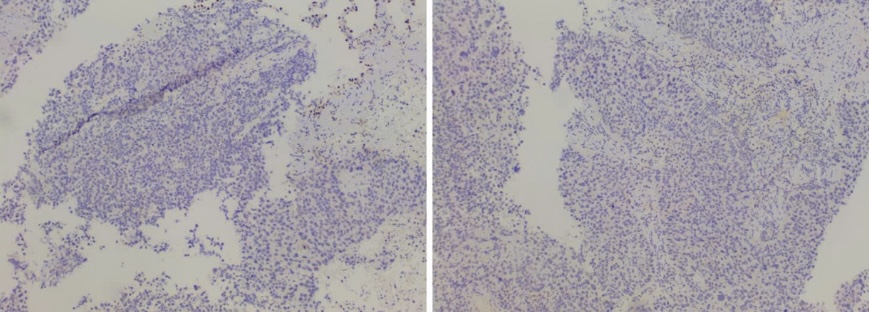For the past month, male patient C.T.H (76 years old, Bac Ninh) has had a dry cough that has been persistent and gradually increasing in severity. Mr. H used medicine but it did not help, so he decided to go to the hospital for a check-up.
After clinical examination, the doctor prescribed the necessary paraclinical techniques for diagnosis. The chest CT scan revealed a dense opaque mass in the upper lobe of the left lung, measuring 43x45mm, with uneven contrast. The image of the mediastinal lymph nodes at the left lung hilum, measuring 21mm and 16mm, was round and had even contrast after injection.
Next, abdominal CT scan showed a hypodense nodule measuring 29x30mm in segment VII, with rim enhancement in the arterial phase.
Detecting abnormal signs, the doctor ordered a histopathological test, diagnosing non-small cell carcinoma. Continuing to perform immunohistochemical tests to confirm the diagnosis, concluding that the patient's condition was large cell neuroendocrine carcinoma combined with poorly differentiated squamous cell carcinoma.
After being accurately diagnosed, the patient is advised by the doctor on appropriate treatment.

Large cell neuroendocrine carcinoma
This is a poorly differentiated carcinoma, consisting of large cells with neuroendocrine features, prominent nuclei, high mitosis, and necrosis. This pathology belongs to the neuroendocrine tumor group according to the WHO 2021 classification, thoracic tumors, rare, accounting for only 3% of lung cancers.
Large cell neuroendocrine carcinoma has a very high malignancy rate, a high recurrence rate, and a lower survival rate than other non-small cell cancers. Even when detected at an early stage, the average survival time after detection is <18 months. In particular, this dangerous disease can easily invade the lymph nodes and metastasize, and is often detected at stages III and IV.
According to the assessment of Master, Doctor Vu Xuan Ngoc - Medlatec Pathology Center, Mr. H's case is even rarer when large cell neuroendocrine carcinoma is accompanied by squamous cell carcinoma (belonging to the subtype of large cell neuroendocrine carcinoma).
"This is probably the first case discovered in Vietnam, because diagnosing this case is very difficult," said the doctor.
Dr. Vu Xuan Ngoc said: Large cell neuroendocrine carcinoma is clinically identified with atypical symptoms. In addition, there are some characteristics such as a higher incidence in men than in women, symptoms of dry cough, phlegm and is closely related to long-term smoking.
Pathology is considered the gold standard in diagnosing this malignancy with 5 criteria such as cells with characteristics of non-small cell carcinoma with neuroendocrine morphological structure (trabeculae, bands, palisades, pseudoroses); High mitotic rate (>10 NC/10HPF); High degree of necrosis; Tumor components with cytological characteristics of other non-small cell carcinoma groups; Tumor cells are positive for neuroendocrine markers and histochemical markers of the corresponding non-small cell carcinoma components.







